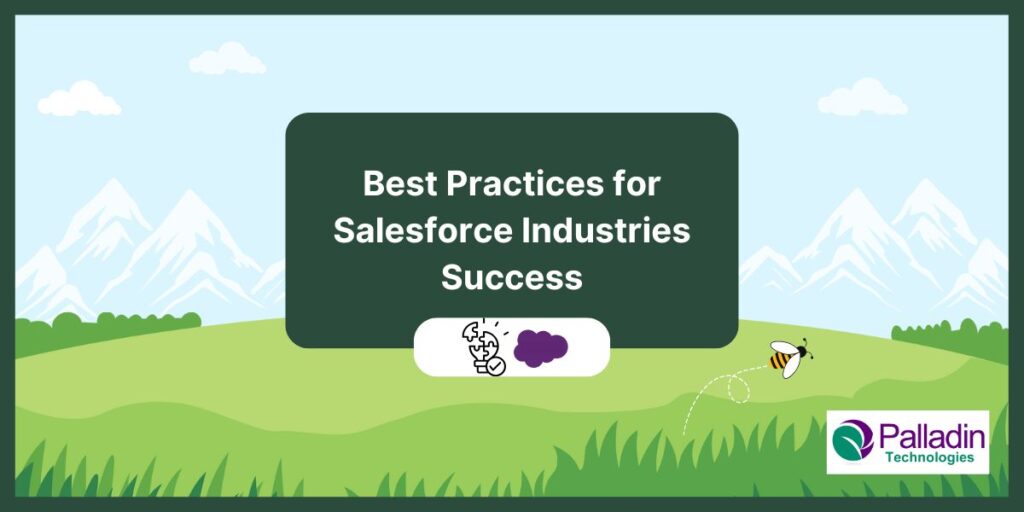Salesforce Industries (formerly Vlocity) implementations call for a comprehensive testing approach to ensure seamless functionality and optimal performance. There are three main key categories of Salesforce Industries testing to establish best practices: Strategy, Scripting, and Execution. By understanding and implementing these practices, organizations can pave the way for successful and efficient Salesforce Industries deployments.
Strategy
1. Execute Test Cases Across All Epics:
To ensure comprehensive coverage, execute test cases across all epics within your Salesforce Industries implementation. This broad approach helps identify and address potential issues early on, promoting a more stable and reliable system.
2. Use the DevOps Approach (TestOps):
Embrace the DevOps approach to testing, also known as TestOps. Aligning development and testing practices streamlines workflows, accelerates testing cycles, and enhances collaboration between teams, leading to faster and more reliable Salesforce Industries deployments.
3. Shift Left Strategies:
Adopt a “shift-left” strategy by integrating testing into the early stages of the development lifecycle. This proactive approach ensures that potential issues are identified and addressed sooner, reducing the risk of costly fixes later in the process.
4. Cost Reduction from Test to Test:
Optimize testing processes to achieve cost reduction from one test cycle to the next. This involves identifying and eliminating inefficiencies, leveraging automation where possible, and continuously refining testing strategies based on lessons learned.
5. Align DevOps and TestOps:
Ensure seamless collaboration between development and testing teams by aligning DevOps and Test Ops methodologies. This integration fosters an environment of continuous improvement, where feedback loops between development and testing contribute to enhanced product quality.
6. Test to Begin from First Sprint and Test Often:
Initiate testing from the first sprint and continue regularly throughout the development cycle. This iterative approach allows for the early detection and resolution of issues, promoting a more efficient and responsive development process.
Scripting
1. Data Load Strategy:
Develop a robust strategy for loading data into the testing environment. This ensures that tests simulate real-world scenarios, providing a more accurate representation of how the Salesforce Industries solution will perform in production.
2. Regression & Performance Testing:
Implement comprehensive regression and performance testing scripts to validate stability and scalability. These scripts help identify potential issues stemming from new features and ensure consistent performance under various conditions.
3. Diversify Test Platform with Different Technologies:
Embrace diversity in testing platforms by leveraging different technologies. This approach ensures compatibility across various environments, offering a more thorough examination of Salesforce Industries functionalities.
4. Leverage Test Scripts:
Develop and utilize reusable test scripts to streamline the testing process. Automation not only increases efficiency but also enhances test coverage, allowing for a more thorough and repeatable testing process.
Execution
1. Key Indicator Performance:
Define and monitor key performance indicators (KPIs) throughout the testing process. These metrics serve as benchmarks for performance, helping to identify deviations and areas for improvement.
2. Scalable Test Approach:
Develop a scalable testing approach that can adapt to the evolving requirements of Salesforce Industries implementations. Scalability ensures that testing efforts can keep pace with the growing complexity and scale of the project.
3. Test Throughout the DevOps Pipeline:
Integrate testing into every stage of the DevOps pipeline, from development to deployment. This end-to-end testing approach ensures that issues are identified and addressed at every phase, contributing to a continuous and reliable delivery process.
4. Baseline Metrics:
Establish baseline metrics early in the testing process to provide a benchmark for performance and effectiveness. These metrics contribute to more accurate reporting and enable effective comparison throughout the development lifecycle.
5. Repetitive Tests for Result Comparison:
Implement repetitive tests to compare results over time. This practice helps identify trends, assess the impact of changes, and ensures that the Salesforce Industries solution consistently meets performance expectations.
Conclusion
Implementing these best practices in Salesforce Industries testing – spanning strategy, scripting, and execution – lays the foundation for a successful and resilient implementation. By executing test cases across all epics, embracing DevOps and Test Ops, adopting shift-left strategies, and optimizing testing processes, organizations can achieve cost reduction, enhance collaboration, and ensure the reliability of their Salesforce Industries solutions. With Palladin Technologies’s proven track record in Salesforce Industries implementations, you can be confident in delivering a successful and scalable solution. Coupled with effective scripting methodologies and strategic execution, these practices contribute to a robust and efficient testing framework for Salesforce Industries implementations.
Learn More About Partnering With Us!
VP, Telecom and Software Engineering
Rahmos Thiao is the VP, Telecom and Software Engineering at Palladin Technologies. Prior to this role, he served as an Engagement Delivery Manager at Salesforce and a Senior Delivery Manager at Palladin Technologies. In these positions, Rahmos played a pivotal role in supporting the sales team during the sales cycle, leading architecture design, and discovering customer business needs to translate them into Salesforce-enabled solutions. Rahmos excels in developing client-specific implementation proposals, managing teams of solution architects, technical architects, developers, and UI architects, and orchestrating cross-team service solutions. He is adept at conducting executive-level communications, presentations, and problem-solving, as well as managing multiple strategic implementations and project deliveries simultaneously. Rahmos also acts as an advisor on complex issues and establishes close working relationships with partners, ensuring successful project outcomes. Additionally, he is skilled in drafting long-term digital transformation programs, including building multi-layer/year digital transformation strategies that focus on putting the customer at the center of the solution. This approach enables customers to self-serve, reduces operational expenses, and increases customer satisfaction.





